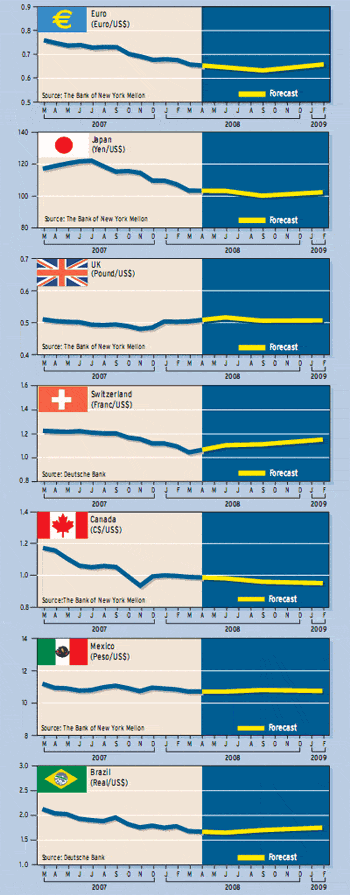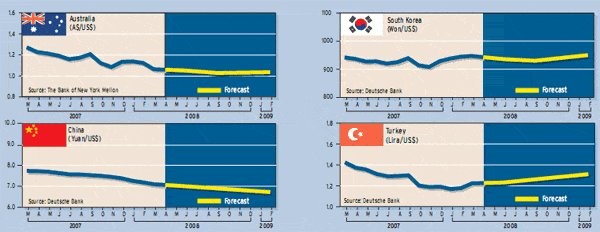CURRENCY FORECASTS

Latin America has experienced its share of currency crises in recent decades, but for the past few years the region’s currencies have continued to go from strength to strength.
“Latin American currencies are on fire,” says Clyde Wardle, currency strategist at HSBC Securities (USA), based in New York. Soaring commodity prices, widening interest rate differentials with the United States and broad dollar weakness are all contributing to regional currency strength, he says.
In a report entitled “Red Hot Chile Pesos,” Wardle and Marjorie Hernandez, analyst at HSBC Securities (USA), examined the outlook for the Chilean peso, which strengthened 12% in the three months through early March. They cited two main pillars of support for Chile’s currency: copper prices and rate differentials.
Structural support for the peso will continue, but in the shorter term its strength looks overdone, according to the report. Copper prices have risen by about 50% in the past 12 months, driven higher by demand from China, India and Russia. Prices for the metal are also supported by supply-side restrictions, including labor disputes and the difficulty in getting new mining projects approved due to environmental, social and other issues, the report says. It concludes that the outlook for copper remains positive, since Chinese demand will remain underpinned by infrastructure development. China’s gross domestic product grew at a rate of 11.4% in 2007.
Meanwhile, divergent monetary policies between emerging markets and the US have been common, and Chile is no exception, Wardle and Hernandez say. Chile’s 6.25% six-month interest rate in early March was 325 basis points above the equivalent US rate and represented the widest difference since the early days of the last US tightening cycle in March 2002.
While the pillars supporting the peso remain strong, the HSBC analysts caution against a potential bout of profit taking in the currency. Investors should also remain alert for political pressure to grow on the central bank to intervene to prevent further Chilean peso strength, they say, adding that such intervention is unlikely. Further advances in the currency could depend on commodity prices, which look stretched in the near term, the HSBC analysts say.
The Brazilian real also has been among the strongest currencies so far this year. “Brazil has been hit with a dramatically positive terms-of-trade shock,” says Marc Chandler, global head of currency strategy at Brown Brothers Harriman in New York. “The prices of its export goods, such as iron ore and soya, are booming, while the prices of its imports are not rising nearly as fast,” he says. This is partly a function of the fact that Brazil, unlike most countries, is largely energy self-sufficient, he says.
Brazil also enjoys robust domestic demand, Chandler says. The country’s retail sales rose 9.6% last year, following a 6.2% rise in 2006. Vehicle sales rose more than 20% last year.
The relatively high interest rates Brazil offers also attract foreign capital flows, according to Chandler. The combination of direct and portfolio investment inflows and the trade surplus, coupled with central bank purchases, have allowed Brazil to accumulate $172 billion of international reserves as of the end of January 2008, he says.
Brazil’s central bank reported that its international reserves have surpassed its gross foreign liabilities for the first time, making Brazil into an international creditor to the tune of about $4 billion. “This, of course, should raise expectations that Brazil will be granted investment-grade credit status,” Chandler says. “We continue to caution, however, that given the rating agencies’ current woes they may be in no hurry to raise Brazil’s ratings,” he says. Brazil’s bond spreads are already within the ranges that one would expect of investment-grade countries, he notes.
Not all analysts are sanguine about the prospects for the commodity-based currencies. “The US recession will slow global demand appreciably and drive commodity prices down and commodity-based currencies as well,” says David Gilmore, economist and partner at Essex, Connecticut-based Foreign Exchange Analytics. “Emerging market currencies, the love children of the past five years, will get spanked on lower commodity prices and a global slowdown in demand,” he says.
“It may take weeks to months to unfold, but the more the dollar deflects everything thrown at it, the more convinced I become that the dollar is putting in a major bottom and, in due course, will recover from current oversold levels,” Gilmore says. “The Teflon dollar is here to stay, and it is only a matter of time before the currency market punishes other currencies,” he predicts.
The dollar fell to a record low of 1.53 euros in early March and to a three-year low of 102.60 yen. The Singapore dollar reached a 13-year high of 1.3881 to the US dollar. The Bank of New York Mellon’s proprietary iFlow indicators, derived from the largest global custody system in the world, confirm that strong net buying of the Singapore dollar seen in recent months is continuing, says Samarjit Shankar, Boston-based director of global strategy at the bank.
The Singapore dollar’s rise began to accelerate in September 2007, when the Federal Reserve embarked on its current easing cycle, Shankar says. With the consumer price index in Singapore rising above the sensitive 3% level to as high as 6.6% in January 2008, it is not surprising that the Monetary Authority of Singapore (MAS) has allowed the local currency to rise to help fight inflation, he says.
BNY Mellon’s iFlow indicators show that very strong net buying of the Singapore dollar began in November 2007. “We suspect this was mainly due to foreign exchange market participants anticipating the MAS’s strong-currency bias in the face of higher inflation and betting on Singapore dollar gains,” Shankar says.
Another factor favoring the Singapore dollar against other Asian currencies is that the Singapore currency has generally been considered as a local safe haven in the Asia-Pacific region, given its lower yields, strong fundamental underpinning and a history of sound monetary policy, according to Shankar. “This safe-haven status has supported the Singapore dollar even during times of risk aversion,” he says. “Given this status and the ongoing high inflationary pressures on the back of elevated food and energy prices, look for further Singapore dollar strength in the coming weeks,” he adds.

Gordon Platt



